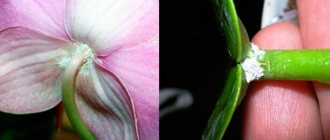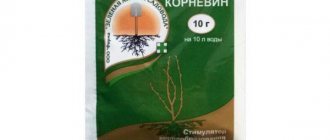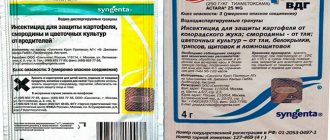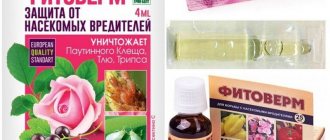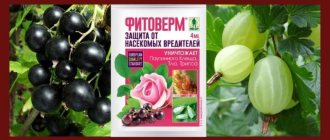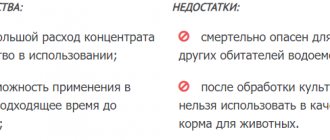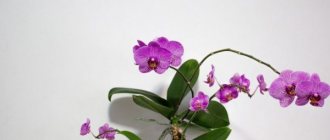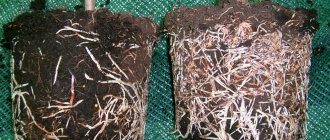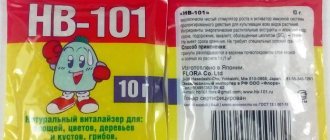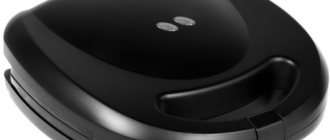Home / Preparations and fertilizers
Back
Published: 06/18/2019
0
3.9/5 — (19 votes)
Aktara is one of the most popular and widespread insecticides among gardeners and gardeners. A wide range of applications and proven effectiveness against most pests are the undoubted advantages of the drug. Like any chemical, Aktara has limitations that should be considered before use.
- 1 Composition and principle of action
- 2 Scope of application
- 3 Advantages and disadvantages
- 4 Release forms
- 5 Security measures
- 6 How to prepare a solution
- 7 Use for different types of crops
- 8 Processing of seedlings
- 9 Compatibility of Aktar with other drugs
- 10 Actions in case of poisoning
- 11 Reviews
Purpose of the drug
Aktara is intended for use as an insecticide from the neonicotinoid group. It effectively controls thrips, lepidoptera, whiteflies, mealybugs, false scale insects, colored potato beetles and aphids on berry and flower crops. The drug is not very effective against whiteflies, and it has practically no effect on arachnid pests.
Aktara is available in various types of packaging
Suitable for indoor plants. Has no effect on resting larvae, pupae, eggs and adults.
Scope of application
The insecticide packaging shows a close-up of the potato beetle, a known enemy of potato beds. However, the range of activities is much wider. Aktara is used against aphids, whiteflies, thrips, bark beetles and many other insect pests. Its effectiveness has been proven against onion flies, cabbage flea beetles and apple moths. Dangerous pests are controlled in several ways:
- soaking the roots of vegetable seedlings;
- processing tubers before planting in the ground;
- application to the soil in beds and flower beds with indoor plants;
- spraying over the entire surface of the above-ground parts of plants.
Spraying plants with Aktara should be carried out when it is necessary to destroy pests that have settled on the site as quickly as possible. Root irrigation is considered the most effective treatment method, since the protective function is maintained for the maximum period of time (on average up to 2 months). Soaking seedlings and treating tubers before sowing can prevent pest attacks.
Packaging and dosage
Aktara is supplied to retail chains in 4 gram packs and 250 g bags. Large packs are intended for large plantations on multi-hectare farm fields or on the plantings of agricultural holdings. 4-gram ones are intended for gardening farms or peasant farmsteads with land areas from 6 to 12 acres.
A small package costs between 80-110 rubles. A 250-gram package will cost the buyer 3,500-5,000 rubles.
We advise you to read: What is the insecticide Confidor, how to use it in the garden?
The best period for treating a plot with Aktara is immediately after the flower petals have fallen from the fruit trees and ovaries have appeared in their place. At this time, bees and other pollinators lose interest in the area, and there is still time before the next flowers appear on raspberries, strawberries and others. Pests have already appeared on the site anyway - albeit in limited quantities for now, but preventive treatment (primarily the soil by watering) will not be superfluous.
Preparation of a solution for treating the above-ground parts of plants:
- A standard 4-gram sachet is dissolved in a 1.5-2.0 liter container at a temperature slightly exceeding 30 degrees.
- 250 ml of water is poured into the manual spraying device.
Next, water is added, bringing it to the desired concentration, keeping in mind the processing of different crops in the area.
- In order to process potatoes, add 150-200 ml of concentrate to the tank
- Currant bushes – 250 ml.
- For decorative flowers (lilies, roses, chrysanthemums, etc.) – 600 ml
The resulting mixture is brought to 5 liters of ready-to-use mixture with water. Then carefully screw the lid on the tank and shake the contents well. At this point the preparation is complete, the sprayer is ready for use.
Despite the complexity of this approach to diluting the mother solution, it is convenient in gradually processing the garden from plants that require a solution of higher concentration to plants that require a lower concentration. In practice, this looks like gradually adding water to the spent mixture, thereby reducing its concentration.
Composition and release form
The drug contains thiamethoxam (an artificially obtained derivative of normal nicotine) in various concentrations (240 g/kg or 240 g/l) with topping.
Release form: in the form of one percent granules or suspension (concentration 25-35%).
| Packaging format: | 0.25 kg. (10×0.25 kg), bag 0.004 kg. (15×0.004 kg. / 10x15x0.004 kg.) |
| Registrar name: | Limited Liability Company "Syngenta" |
Active substance
The main active ingredient is thiamethoxam. It accounts for ¼ of the weight of the drug, and the share of other useful substances - ¾. Aktara is absorbed into the leaf tissue through the cuticle and into the deep layers of the roots during watering. The drug quickly moves through the vessels and fills all tissues. The insecticide is effective even when the room is hot.
What kind of insecticide is Aktara?
Aktara insecticide is a new generation drug that can be characterized by rapid action and very high efficiency. This product provides reliable plant protection for a long time, usually 25-55 days.
It all depends on the method and standards of application. Experts confirmed that this drug belongs to the class of low-toxic pesticides.
Most often it is used when spraying vegetable and grain crops, berry bushes. Aktara insecticide is classified as a neonicotinoid with enteric contact action.
The insecticide drug Aktara is a new generation drug created on the basis of thiamethoxam. This is the main active ingredient with a wide spectrum of action. The above-mentioned product works both when applied to the soil and when treating plant leaves on the surface.
This drug is produced in several forms:
- in the form of a liquid concentrate in containers with a capacity of 9 ml, 250 ml, 1 l.;
- in the form of water-dispersible granules, which are packaged in polymer bags of 1, 2 and 4 grams;
- in the form of a soluble powder, which is packaged in foil bags of 4 grams;
- in the form of tablets in special blisters.
The highest percentage of thiamethoxam (the main active ingredient) is contained in liquid form, and the smallest in tablet form (only 1%).
Principle of pest control
After spraying or watering the soil with an insecticide solution, its active substances penetrate the cells and vessels of all parts of the plant and remain there for a long time. Sucking or leaf-gnawing pests eat poisoned parts of plants or feed on the cell sap of Aktara, thereby poisoning the body of the pest.
The drug acts on receptors in the nervous system and paralyzes them. As a result, insects lose their ability to feed within an hour. Death occurs approximately 5 hours after poisoning.
Harm from scale insects
All scale insects cause enormous damage to plants; in gardens they can completely destroy an entire fruit tree in 3-4 years. In countries with a warm climate, in agricultural regions, when certain types of scale insects (for example, mulberry) are detected, strict quarantine is introduced. During this period, the export of seedlings and seedlings is strictly prohibited. Fruit trees and shrubs, stone fruits and tea plantations are treated with pesticides.
In indoor conditions, scale insects, having settled on a plant, will also lead to its death in the shortest possible time. Scale insects come into our house with infected flowers from the store, planting material (soil), and stray insects are carried in by the wind.
At the site where the scale insect is sucked, yellow spots appear on the leaves; they grow in size as the cell sap is sucked out, then the leaf turns completely yellow or brown, curls and falls off. The plant stops growing, the branches become bare, then the entire bush begins to dry out and the plant dies. In addition to the leaves, the scale insect damages the fruits of citrus fruits (tangerines, lemons and oranges), the ovaries fall off prematurely, and the flowers dry out.
Another sign of scale insects is sticky discharge on the leaves. Scale insects produce a sweetish liquid - honeydew, which covers the stems, leaf petioles, leaves, buds and fruits. Sooty fungus and dust stick to it.
What pests does it help with?
Effective against pests of indoor plants, garden trees, vegetable crops and open ground flower beds. The list includes:
- ground flies;
- fungus gnats;
- false scale insects and scale insects;
- thrips;
- all types of aphids;
- whiteflies;
- Colorado beetle;
- leafhoppers;
- harmful turtle (bug);
- cruciferous flea beetles;
- mining moths;
- drinker;
- wireworm;
- bread ground beetle;
- cabbage cutworm and cabbage cutter;
- pea codling moth;
- pea grain;
- thrips and others.
When spraying plants, the aerosol hits caterpillars and beetles, then penetrates their body, and the poison begins to act. The insects eat the poisoned plants, ingesting the insecticide, which destroys their nervous systems. After half an hour, the parasites cannot eat anything and soon die. If the insecticide is applied to the soil, underground pests die.
The drug "Aktara" costs 75-100 rubles per pack of 4 grams, and 3.5-5 thousand rubles per 250 grams, respectively. The product should be stored in utility rooms, on high shelves or in closed cabinets. Children and animals should not enter there.
It is not recommended to store food, medicine or feed near the product. The room temperature should be from 10 degrees below zero to 35 degrees above zero. Do not store Actara in places with high humidity.
From the Colorado potato beetle
"Aktara" is a paralyzing poison that acts on the receptors and nervous system of the pest. Within 15-30 minutes, the potato beetle stops eating the plant and dies within 2-24 hours.
Aktara is addictive, so it should be used interchangeably with other insecticides.
It is important to know that Aktara acts differently on different insects. For example, for a bee it represents the first class of danger, and for aquatic and terrestrial insects it represents the fourth.
From aphids
After treatment, the drug is absorbed into the vascular system of plants, shrubs and trees, bypassing the fruits. After treatment, aphids stop eating plants, flowers and leaves.
The active ingredient thiamethoxam completely destroys the ability of aphids to survive within half an hour, so they die within a day.
From spider mites
Spider mites very often attack indoor plants; fighting them is very difficult, and not all remedies are effective. As for Aktara, where the instructions for use for indoor plants indicate that it is not suitable for controlling ticks, it can be used. Some gardeners claim that this helps and the tick dies. However, positive claims about the drug's effects usually refer to the first use. With subsequent spraying, Aktara may not be as effective.
From whitefly
Small whiteflies on orchids spread quickly and infect almost all the plants in the collection. Whiteflies are small insects with folded wings. The body appears to be covered on top with a layer of white powder.
The invasion of this insect causes yellowing and dropping of leaves. The pest makes the plant more susceptible to fungal, viral and bacterial infections.
Start the fight against whiteflies by replacing the growing medium and removing infected leaves. Treat the plants with Actara. Water the soil with a weaker solution.
From ants
Some gardeners speak positively about these insects. They claim that black garden ants are good for both soil and plants:
- in the process of obtaining protein, they fight off many other pests, larvae and caterpillars;
- they are food for birds;
- they pollinate plants and flowers;
- they loosen the soil by making holes in it, providing the roots of plants with oxygen.
From onion fly
Spray the plants against onion flies with a solution prepared from 4 g of the drug and 10 liters of water. Dissolve the granules in warm water (temperature should be at least 25°C).
This volume is designed to process 10 m2. The bulbs are sprayed for the first time when the dandelions begin to bloom, and after 1-1.5 months the plants are sprayed again.
From mealybug
Another mistake that is easy to recognize and difficult to ignore. Also known locally as hair louse. It got its name because of the cotton-like marks that it leaves on the leaves and in the internodes of plants. These are the simplest ways to determine it. The parasite resembles a woodlice, and its larvae resemble small sesame seeds. For some reason, it likes to attack desert rose in late fall and winter.
The pest most often settles on the underside of leaves, young shoots, buds and flowers. It is easiest to detect it at the tops of adeniums, where a large number of individuals accumulate and new leaves become deformed.
Adenium is infected with worms. The photo gives the impression that the plant has been sprayed with water. But in fact, this is the result of the activity of insects - secretions that have formed a sticky coating on the leaves.
From thrips
The difficulty in killing thrips is that this insect goes through four stages of development in different parts of the plant, including the ground.
Treatment is carried out by spraying the soil and spraying every week for a month. The solution is prepared in maximum concentration.
To avoid insects becoming accustomed to Aktara, the last 2 treatments should be carried out with a different group of insecticides.
From scale insects
The shield aphid is a dangerous pest of orchids. Fine brown scales or waxy bumps and sticky discharge on leaves and stems are signs of infestation. Adult pests are difficult to remove because they literally bite into plant tissue.
The length of the insect ranges from 1.5 to 4 mm. Wings develop only in males, but the oral apparatus is reduced. Large females have neither legs nor wings. The waxy scutellum protects well from the penetration of chemicals through the integument into the body.
Scylla and false moths are combined into one superfamily Coccidae or ringworms - sucking insects that are dangerous to many plants. Pests of orchids include 4-5 species of lepidoptera and soft pseudo-lepidoptera. This group of insects is extremely difficult to control.
Before getting rid of scale insects, it is necessary to isolate the affected plant from healthy ones. Then remove all brown tubers. It is recommended to change the substrate, disinfect the pot and treat the orchid. Then it will be necessary to carry out the second and third treatments at intervals of 5-6 days.
Reviews
Elena, Norilsk: I tried everything I could to save my beautiful ficus from whitefly, but Aktara helped. First, I sprayed the leaves, and after 2 days I applied the freshly prepared solution to the root. Spraying was repeated 4 times, gradually increasing the concentration of the solution due to the insects becoming accustomed to the drug. I never saw this crap again.
Galina, Ivanovo: There are aphids on my calendula. Mechanical removal did not help get rid of the pests forever, and on the advice of a friend, I used Aktara. To make the solution stick better to the leaves, add milk. The number of parasites decreased noticeably the next day. After 2 weeks I treated the leaves again. The aphids were completely destroyed.
Olga, Mytishchi: “Aktara” saved violets from scale insects. Spraying was carried out three times, with an interval of 10 days. The product is highly effective and has no unpleasant odor.
Consumption rate, dosage
The solution is prepared in warm water (the granules dissolve at a temperature not lower than 25°C), 8 g of the drug per 10 liters of water - for watering the soil in pots (or garden soil) against aphids, whiteflies, thrips, scabies and false scales, mealy bugs and rainbugs worms The consumption rate is 10 liters per 10 m² (approximately 200-250 pots).
To use Actara on houseplants against most pests, spray and water with the Actara solution at the same time. To do this, 1 sachet of actara weighing 4 g must be dissolved in 5 liters of water to spray the entire greenhouse, so it is recommended to dilute 1 g in 1.25 liters of water. The easiest way to do this is to pour the actara onto a white sheet of paper and divide it by eye into four piles - each will contain approximately 1 g. Dissolve 1 g of powder in individual bags and use as needed, dissolving in 1 liter of warm water.
If you use Aktara against weak pests: soil bugs (sun dew, coleoptera, enchytraea) or fungal gnats, dilute 1 g of Aktara per 10 liters of water for irrigation.
The difference between Aktara in ampoules and powder
The effectiveness of liquid and dry products is the same, but for treating indoor flowers it is more convenient to use the drug in ampoules. It is easier to dilute and dose, all contents are used immediately. Insecticide consumption: 1 ampoule per 5-6 liters of water.
The granule solution is prepared in 2 stages. First, a portion of the powder is dissolved in a small amount of warm water and mixed thoroughly. The mixture is allowed to settle, then poured into a large container, the required amount of water is added and mixed again.
On a note! It’s okay if a small precipitate forms in the prepared solution.
When to treat
Cabbage seedlings should be treated with Aktara in the morning, since at this time the absorption of the drug by the root system is very high.
The solution for watering open soil is 8 g per 10 liters of water.
Approximately a few days before watering, the soil should not be watered to avoid the drug seeping into the soil.
The duration of action is 2-3 weeks.
To combat whiteflies on cabbage, increase the concentration of the solution or combine with other insecticides.
Use for various types of crops
The standard bag contains brief instructions for using Aktara for plant protection. The concentration varies depending on the specific crop and type of treatment.
| Culture | Pest | Drug consumption |
| Potato | Colorado beetle | 1.2 g per 10 liters of water. Spray once. Waiting period 14 days |
| Currant | Aphid | 2 g per 10 liters of water. Spray before flowers appear, re-spray after harvest |
| Tomatoes, eggplants, sweet peppers | Aphids, Colorado potato beetles, whiteflies, leafhoppers | 1.4 g per 10 liters of water. Spray once after an attack by pests 4 g per 10 liters of water for application to the soil |
| Cabbage | Aphids, flies and flea beetles | 3 g per 10 liters of water. One-time spraying. Waiting period 3 weeks |
| cucumbers | Aphids, whiteflies, tobacco thrips | 2 g per 10 liters of water. Spray once until buds appear. 8 g per 10 l for application to the soil |
| Grape | Cicadas | 3 g per 10 liters of water. Single spraying |
| Apple tree | Codling moth, aphid, copperhead | 3 g per 10 liters of water. Spray once before or after flowering. |
| Fruit trees | Aphids, codling moths, honey moths, scale insects | 4 g per 10 liters of water. Spray once before or after flowering. |
| Potted crops | Aphids, scale insects, whiteflies, flies, false scale insects | 1 g per 10 liters of water. Spraying in case of pest attack. 0.8 g per 1 l. Application into the soil after moistening the soil. |
Helpful information! If the bag contains more drug than is required for a single treatment, the granules are poured onto a paper sheet and divided into equal portions using a toothpick. The required amount is used for further preparation. The remaining “piles” are poured into plastic bags with an airtight closure.
Instructions for use, how to dilute for spraying
The insecticide can be used to spray soil fragments or to spray the roots. Regardless of the application, it is recommended to first make a working solution. It is recommended to dilute the composition outdoors. It should not be cooked indoors.
It is better to mix the drug with warm liquid. Its temperature should be at least +25 degrees. This will ensure good dissolution of the granules. To water at the root, use 8 grams of the substance per bucket of water. This composition will save you from thrips, scab, and aphids. It also kills powdery mildew and rootbugs. The consumption of liquid insecticide per 10 square meters of plantings can reach 10 liters.
To get rid of caterpillars, thrips, aphids and other parasites, it is recommended to take into account the type of crop being treated:
- To water tomatoes growing outdoors and in greenhouse conditions, mix 4 grams of the substance with 10 liters of water. This will help get rid of whiteflies. This mixture is effective against aphids and potato beetles. To spray, use 1.2 grams per bucket of water.
- To protect eggplants and peppers from thrips and aphids, water them with a solution containing 4-8 grams of the drug and 10 liters of water. To spray leaves, use 2-4 grams of product per 10 liters of spray.
- To kill whiteflies, aphids and thrips on cucumbers, use 8 grams of Aktara per bucket of water. Use this solution to water your garden beds. To spray leaves, use 4-8 grams per bucket of water.
- To destroy fruit flies and honey beetles on apple trees, it is recommended to spray the plants with a solution consisting of 3 grams of the drug and 10 liters of water. For pears, use 4 grams of the substance per 10 liters of liquid.
- To destroy onion flies and thrips on onions, mix 4 grams of the composition with 10 liters of water. The product is suitable for spraying above-ground parts of plants.
- If thrips appear on rose bushes, mix 16 grams of Aktara with 10 liters of water. To combat aphids, no more than 4 grams are required.
- If you need to kill flies and fleas on cabbage, water the seedlings with the solution. To make the solution, mix 3 grams of the aphrodisiac with a bucket of water.
The dosage for fruit trees and vegetable crops is usually the same. On average, 4-8 grams of product per bucket of water.
The drug is completely distributed in plant tissues 20 hours after watering. For large plants this may take 1 to 3 days.
The hatching period is from the moment the plants are processed until the moment the fruits are harvested. When spraying plants, wait 14-21 days; when watering at the root, the time interval increases to 40-60 days.
Preparation and processing
Dissolve the contents of the ampoule in a small amount of water and mix thoroughly. Fill with water to the required volume in accordance with the required dosage. Treatment should be carried out in calm, rainless weather, during daylight hours. The optimal ambient temperature is +12…+25 degrees Celsius. The minimum waiting time for protective actions is at least 4-6 hours.
| Culture | Pest | Dosage | Processing method | Validity |
| Potato | Colorado potato beetle, wireworm | 1ml/3-5l.water | Spraying during the growing season, consumption up to 5 l/100 sq.m. | 3 weeks |
| Currants, gooseberries | Aphids, spider mites | 1ml/5l.water | 1st treatment before flowering - 1.5 l./bush 2nd treatment after harvesting 1.5-2 l./bush | 5-6 weeks |
| Houseplants | Aphids, thrips, whiteflies, false scale insects, flies. | 1ml./10l.water | Watering the soil during the growing season and spraying in the presence of pests | 1-2 weeks |
| Cabbage | Cabbage fly | 2ml/10l.water | Spraying or root watering | 2 weeks |
| Peas and legumes | Aphids, grains | 1-2 ml / 10 l. water | Spraying during the growing season, consumption 3-5 l/100 sq.m. | 2-3 weeks |
For potatoes
For potatoes, use Aktara against potato beetles and powdery mildew. Dilute in the following proportion: 2 ml of Aktar per 6-10 liters of water. The treatment is carried out during the period of active growth of the green mass of potatoes, the consumption of the working solution is a bucket of solution per 100 m2.
For indoor plants
Dilute a 1.2 gram ampoule of the drug in 6 liters of water (enough for 100-150 small plants); after treatment, the room remains closed for 6 hours after spraying or 2 hours after watering.
When processing indoors, the operator should remain in the room with the door completely closed only after wearing personal protective equipment.
You can read more about the use of the drug on indoor plants in our specialized material here.
For fruit trees, shrubs
Treat with one ampoule of Aktara dissolved in 6 liters of water. Pour 100 ml under each bush 1 m high, and 150 ml under a currant bush 1.5 m high.
The first treatment is carried out after harvesting, the second after the formation of leaves, but no later than a week before flowering.
Read more about the specific effect of the drug on trees in this material.
For roses
Roses and other ornamental plants can be rid of pests by diluting 8 g of the drug in 10 liters of water.
For orchids
Dilute 4 g of Aktara in warm (25 degrees Celsius) water (volume - 5 liters) and spray on orchids.
If cobwebs appear on orchid leaves, spray immediately
If the drug is purchased in ampoules, use the following dosage: 1 ampoule per 750 ml of water.
For cucumbers in greenhouses and open ground
In a greenhouse on flowering cucumbers, Aktaru can be used against aphids, whiteflies and thrips, but not on those that grow in the garden bed. The product is toxic to pollinating insects. Pollen poses a threat to bees and bumblebees even several months after treatment.
Note: After applying Aktara insecticide to cucumber plants in the greenhouse, close the doors and windows to prevent insects from entering.
Whiteflies and thrips are found on greenhouse cucumbers. Aktara insecticide is effective in the early stages. Cucumber bushes are treated twice. Cucumbers should not be eaten within 3 days after the insects emerge from the leaves, so the grown fruits should be collected before spraying the plants.
With repeated treatment of plants, insects become resistant to Aktara. Treat cucumbers during the season with drugs belonging to different chemical groups so as not to cause addiction.
A good effect is achieved by applying alternately:
- Aktara;
- Match;
- Karate;
- Actellik.
The use of other nicotinoids (Cruiser, Doctor) during repeated courses of treatment is pointless. These are analogues of the drug Aktara.
Features of using Aktar in a greenhouse are given in the table.
| Culture | Stage | Solution supply method | Pest | Concentration | Consumption |
| Cucumber | The length of the central stem is less than 1 m | Drip irrigation | Tobacco thrips, whitefly, aphid | 4 g per 10 l | 2500-5000 l/ha |
| The length of the central stem is more than 1 m | Drip irrigation | Tobacco thrips, whitefly, aphid | 8 g per 10 l | 2500-5000 l/ha | |
| During the growing season | Spraying | Aphid | 1-6 g per 10 l | 1000-3000 l/ha |
For cabbage
Use Aktara against cabbage fly on this vegetable crop. Dilute the product in the following proportion: 2 ml in a bucket of water. During the season, you can spray cabbage plants or apply a solution at the root. Cabbage plants can be protected from pests by applying Aktara for 14 days.
For grapes
Aktara will protect grapes from cicadas and similar insects. For reliable action, dissolve 3 g in 10 liters of water and spray the entire vine before flowering.
For conifers
Coniferous trees are mainly attacked by pine spider mites, spruce parasites and spruce aphids. To combat coniferous plants, Aktara is diluted at the rate of 5-8 grams (1.5-2 sachets) per 8-10 liters of water.
Aktara and coniferous trees
Take care of coniferous trees in the warm season. For coniferous species, spraying is preferable; watering in this case is ineffective.
For strawberries
The whitefly, which parasitizes strawberries, is not without reason considered one of the most harmful pests. Since adult insects can reproduce several times per season, you need a good, proven way to get rid of them.
Strawberry whitefly attack
Aktara has proven itself in the fight against whitefly on strawberries.
For tomatoes
Tomatoes are sprayed or scattered at the root. In the latter case, a dose of 3 g for every 10 liters is used.
For seedlings and seed material
Since Aktara spray must be carried out with a solution, the prepared and appropriate amount of dry powder must be diluted with water. The seeds are treated with a mixture prepared in accordance with the instructions.
Processing of seedlings
Aktars are often used to treat potato tubers before planting in open ground and for preventive treatment of seedlings. The procedure is carried out before planting seedlings in a permanent place. The procedure is as follows:
- 1.4 g of Aktar granules are dissolved in 1 liter of warm water;
- seedlings of tomatoes, peppers, eggplant are soaked in the solution for 2 hours so that the roots of the seedlings are evenly wetted with the liquid;
- no later than 12 hours after treatment, the plants are planted in the ground.
To process potato tubers, use 6 g of granules diluted in 0.5 liters of water. The planting material is laid out on polyethylene and sprayed with the resulting solution using a spray bottle. Wet tubers are mixed to evenly distribute the substance and immediately planted in the beds. Potatoes processed in this way are not stored.
Duration of impact
After applying Aktara, it remains in the vascular system of plants and protects against pests (when applied per leaf) for another 24 days. "Aktara" is not washed off by rain and water when watering.
For garden plants, the drug is poured under the root even before flowering. When watered at the root, the effect lasts 40-60 days, so one treatment is required. Young shoots also remain protected.
In case of spraying, Aktara is less effective. The holding time is reduced to 14-28 days.
When spraying plants that do not bear fruit, the effectiveness of the drug remains for 28 days.
Herbs (for example, parsley and dill) cannot be treated with Aktara.
Precautionary measures
This is a class III insecticide. It has low toxicity, but during operation and during the preparation of the working solution, safety precautions must be observed:
- protect the respiratory system with a respirator;
- Avoid getting the product in your eyes - wear safety glasses;
- work in a work suit that covers the skin of the hands and feet;
- wear rubber gloves.
Important!
Requirements for weather conditions: weak or no wind, no precipitation, dew, bright sun.
The effectiveness of the drug and its safety depend on the weather. Rain after spraying will wash away the insecticide. The wind will reduce its concentration on the leaves of cucumbers, because of which splashes can get on the skin of the face. Due to the frequent use of the drug Aktara in the country, the number of earthworms decreases.
The insecticide is dangerous for bees - hazard class I, so it should not be used near apiaries. The protection zone is 4-5 km. After treatment with Aktara, cucumbers pose a threat to wasps, bumblebees, and bees for 96 hours.
Safety rules and toxicity
The drug Aktara is classified as moderately dangerous (class 3), but at a concentration of 0.02%, i.e. about 2 grams of active substance per liter of liquid, it goes into the second class. Therefore, when working with this substance it is necessary to use all personal protective equipment, namely:
- protective glasses;
- petal respirator;
- headdress;
- special clothes and shoes.
The hazard class of a chemical varies for different insects. So, for a bee it is the first, and for aquatic and terrestrial insects it is the fourth.
Do not smoke, eat or drink while handling plants. After the maximum permissible operating time of 2 hours has passed, you should stop processing plants and trees, wash your hands with soap and water and take a shower. Plastic protective equipment should also be washed and work clothes laundered.
Water used for washing protective equipment and containers, as well as the remaining solution, should not be poured onto the ground, especially in areas where drinking water is collected and near water bodies. In order to properly dispose of a liquid containing Aktara, add a solution of baking soda to it, and then, after waiting 5-10 minutes, pour it down the drain. Chemical packaging should be incinerated or disposed of.
Since bees can be poisoned by Aktara poison, which is not completely absorbed and enters their body through normal contact, the safe zone separating bees from treated plants should be at least 4-5 km. At the same time, after applying Aktara, four to five days must pass before the bees are released into the wild.
Actions in case of poisoning
It is recommended to take immediate action if symptoms occur during work. To do this it is useful to do the following:
- Take the person outside as soon as the first symptoms of poisoning appear. They usually manifest themselves in the form of nausea, vomiting and general weakness.
- If the mixture gets on your skin, wipe the contact area with a clean cloth. It is not recommended to rub it into the skin. The affected area should then be washed with water.
- If the substance gets into your eyes, rinse them with running water. It is recommended to do this within a quarter of an hour.
- If the substance has been swallowed and the person remains conscious, give the person an activated charcoal solution and induce vomiting. However, this should not be done if the person is unconscious. In such a situation, you should immediately call an ambulance. There is no specific antidote for Aktara. Therefore, doctors recommend symptomatic treatment.
Actions in case of poisoning
When working with the drug, it is necessary to avoid contact in every possible way with both granules and suspension, and with the working solution. Otherwise, you need to act immediately:
- if drops of the solution get on the skin, they must be thoroughly washed off with a detergent;
- If the chemical gets into your eyes, rinse with cool water for at least 5 minutes;
- If it enters the digestive system, you should take the absorbent and drink plenty of water.
Symptoms of insecticide poisoning include nausea, swelling of the eyelids, and dizziness. In this case, it is recommended to seek medical help.
Advantages and disadvantages
This insecticide is deservedly popular among gardeners. Aktara's strengths include:
The speed at which the drug acts on pests. The insects eat the poisoned leaves and receive a lethal dose of the poisonous substance, which within half an hour causes paralysis, which then leads to death.
Effective against a wide range of pests, including insects that parasitize the undersides of leaves.
Absence of the unpleasant odor characteristic of most insecticides in dissolved form. For this reason, Aktara can be used indoors to treat indoor plants.
Weather resistant. Its effectiveness is not reduced by high temperatures or exposure to ultraviolet radiation. After absorption, the product is not washed off by precipitation.
Safe for humans if precautions are taken.
Toxic substances are not concentrated in processed fruits, so hygienic safety is not compromised.
Can be combined with other products to protect against insect pests, fungal diseases, and stimulate plant growth.
Aktara insecticide is also characterized by certain limitations that should be familiarized with before use:
It poses a threat to natural pollinators of garden plants - bees, bumblebees, wasps. Poison damage occurs when insects come into contact with the solution. The flight limitation after using Aktara is 4-5 days.
Causes pests to become addicted to the active substance. It is necessary to alternate the use of this drug with other insecticides of a similar purpose.
It is not compatible with alkaline preparations and fertilizers.
Aktara is not able to protect against dense-winged insects and non-drying pests.
Compatibility of Aktar with other drugs
One of the advantages of Aktara is that the drug can be used in combination with most herbicides, pesticides, and growth stimulants. This property allows the insecticide to be used in tank mixtures. Gardeners combine Aktara with Fitosporin M, Epin and Zircon. Before use, it is advisable to conduct a compatibility test of the active ingredients. To do this, mix a small amount of drugs and observe the consistency of the resulting solution. If sediment appears at the bottom, there is no practical point in using the mixture.
Price
The price of the drug is up to 100 rubles per 4 grams. 250 grams costs about 4,000 rubles. The packaging should be stored in a dry place, in closed cabinets, out of the reach of animals and children.
It is not recommended to store the substance in the refrigerator or near food. The temperature should be 10-30 degrees Celsius.
There are different editions of this drug. The medicine itself comes from Switzerland. It protects vegetables, orchids, violets, roses and houseplants. "Aktara" against ticks helps control the pest, but the drug does not guarantee its complete disappearance. Types:
- Particulate matter (4 g per sachet). This is enough to sprinkle tomatoes in a greenhouse. Of course, there are discounts on wholesale prices for large farms.
- Suspension for processing.
Why is scale insects dangerous for indoor plants?
The insect, up to 5 mm long, belongs to the subfamily of scale insects. Thanks to its shell (scutellum), it looks like a brown plaque. The threat that pest colonies pose to indoor plants is enormous because:
- Males have wings and can fly from place to place, infecting new plants.
- The female lays about 3000 eggs at a time, and the number of pest colonies increases quickly.
- The insect leaves behind a sticky trail, which serves as a breeding ground for the spread of fungal diseases.
- It is extremely difficult to remove the parasite from a leaf.
During their life, scale insects suck the juices out of the plant, causing the leaves to turn yellow, dry out and fall off. Orchids, ficus, palm trees, and citrus plants (in particular lemons) are most often affected.
